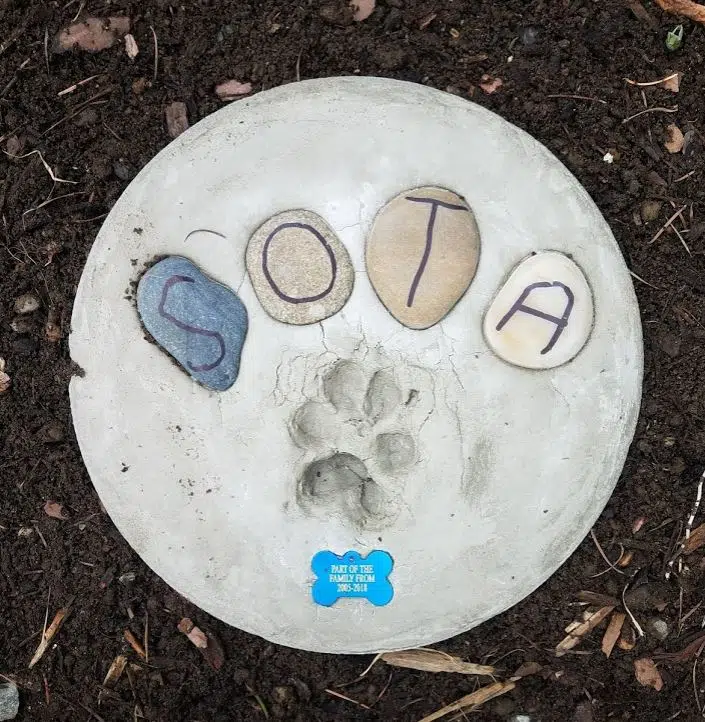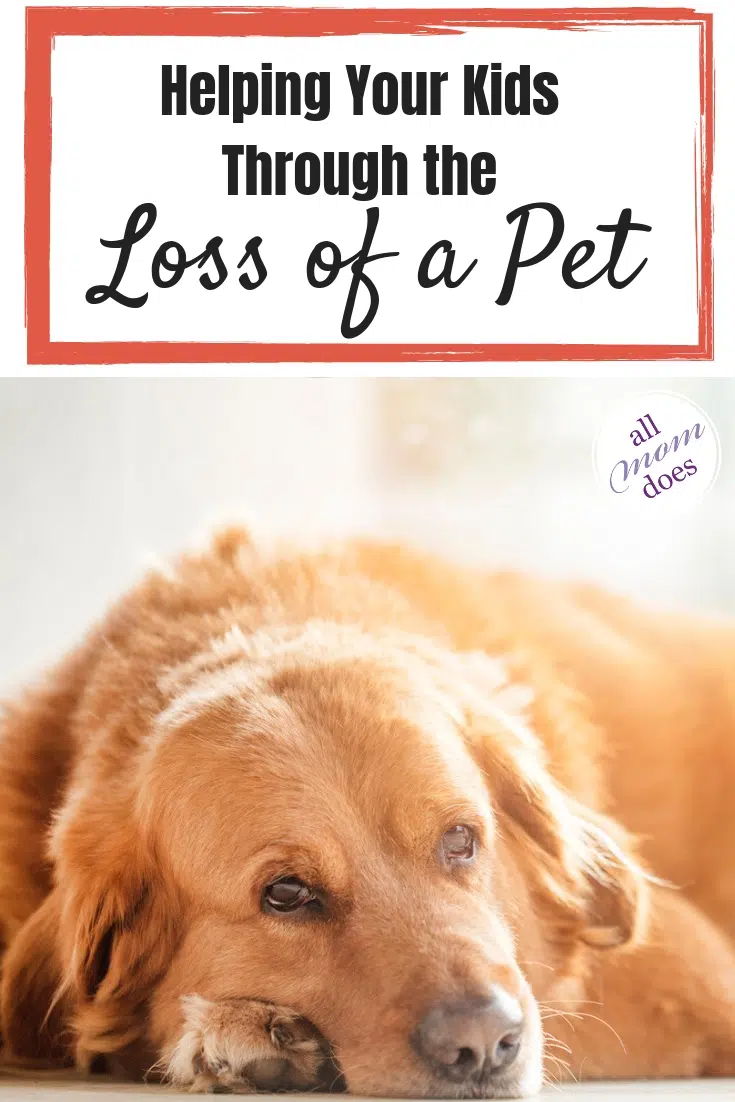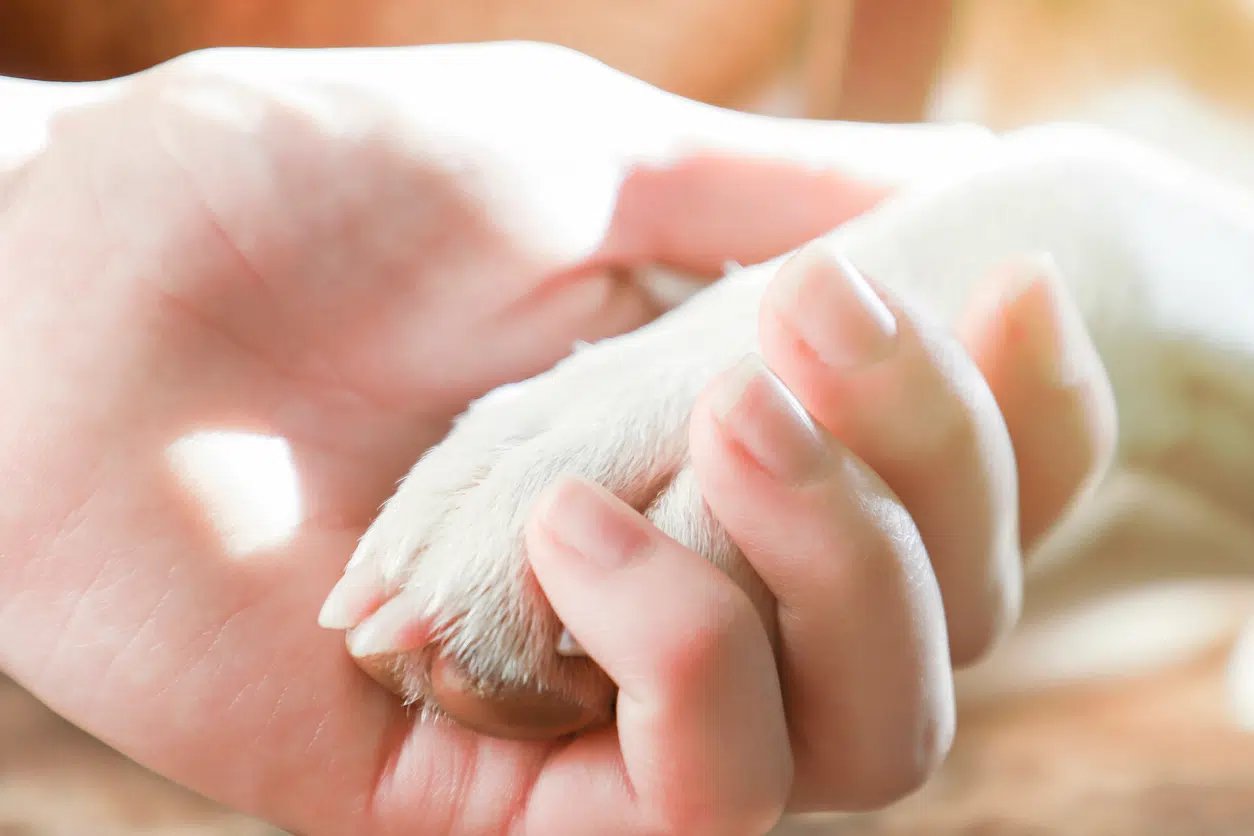We knew our dog was getting older. As she advanced in years her mobility got increasingly worse and there were several times when we thought we were close to the end. For two years, in fact, we thought her days were numbered. Then, shortly after her 15th birthday last April, it became clear that her time with us was up. But she’d been with our family since before our kids were born – they had no frame of reference of what life would be like without Sota in our lives. So though my husband and I were sad when the time came, we also knew it was important to help our kids walk through the process of grief and saying goodbye.
It was still heartbreaking, but overall it was a peaceful experience for everyone involved. And after going through it with my children (ages 5 & 9), here are my best tips on helping kids through the death of a pet.
Raise them with the understanding that their pet won’t be there forever. Pets don’t last a lifetime, so it shouldn’t be a surprise when they pass. Raise your kids to have a concept that their pet won’t be there forever. This doesn’t have to be a constant, morbid reminder. Just mention it every once in awhile. In fact, as our dog advanced in years we mentioned it much more frequently so it wasn’t a complete shock when the moment came. Example: “Spot just had his fifth birthday! Did you know the average lifespan for this type of dog is ten years? We want to make sure we take him on walks and keep him healthy so he can have the best life possible with us for the rest of his years.”
Tell them in advance when death is imminent (if possible). Accidents and emergencies happen, so this isn’t always possible. Plus, I also know not everyone will agree with me on this point as it’s an individual decision. But we struggled for months with the idea of putting our dog down, not wanting to rob her of “good days” by making the choice too early. But after agonizing over this for a very long time and pouring over end-of-life checklists for dogs that help you decide “when it’s time”, our sweet girl had a medical episode that made it clear she was quickly headed downhill. In that moment we made the decision to schedule euthanasia for her a week in advance so 1) We could have the time to say goodbye, and 2) It would be peaceful for both her and for us. I didn’t want the final moments of her life to be scary for her, or for our kids to be scared or traumatized by a medical episode or emergency that made the end of Sota’s time with us abrupt. We told our kids right away after scheduling the appointment that she would be dying in a week, and that we needed to spoil her for the rest of her life with our family.
Looking back, it was a sweet time filled with {short} walks and snuggles, and the night before we put her down the kids made a special bed for her out of all their pillows, blankets, and stuffed animals. Both of the kids express gratitude that they knew in advance so they had that special time with her to prepare themselves.
Don’t get angry if they don’t seem to understand. My daughter was five at the time, and treated the dog’s death like a vacation countdown. Every morning she’d wake up and exclaim “FIVE DAYS UNTIL THE DOG’S GONNA DIE!” It was annoying since it was supposed to be a somber time, but it was her way of dealing with things. She didn’t completely understand the gravity until my husband left with the dog one final time, but she did have a concept of what was happening. It wouldn’t have been helpful to get upset with her for “not getting it.”
Let them say goodbye. Give your kids the opportunity to say goodbye privately and unhurried – preferably before the minute you’re planning to walk out the door. The grief will hit them unexpectedly – don’t try to time it perfectly. They may be more comfortable dealing with their emotions by themselves with the animal, but stay close in case they indicate they need you.
Don’t bring them to the appointment. If you’ve chosen to put your pet down, don’t bring your child to the appointment. It’s sad and it’s clinical and they probably won’t completely understand what’s happening. Though you know your child best {older kids may be more appropriate if they really want to attend the appointment}, many vets won’t even do the procedure if you show up with kids. Think about this clearly and if it’s incredibly important to bring your child, make sure you check with your vet in advance. There are also people that will come to your home, but again, check with them about their child attendance policy. My husband took our dog and I stayed home with the kids. If your kids won’t be staying home with a parent, make sure you choose a caregiver they’ll be comfortable to grieve with.
Let them have space. Just because they’re little people doesn’t mean they have little emotions. They have big emotions, and sometimes they don’t know how to express them. We let both of our kids stay home from school that day because we didn’t want them to have to deal with too much in one day, even if it wasn’t overtly apparent that they were struggling emotionally. There was stuff going on beneath the surface.
Offer closure or have a ceremony. After your dog has passed, have some sort of closure ceremony/funeral/memorial. This doesn’t have to be lengthy or formal. We just set a stone in our garden, said a prayer of thanks that we got to have her for so long, and shared memories. The whole thing lasted about 10-15 minutes.

Talk about the lost pet. Don’t be afraid to talk about your pet for fear that you’ll upset your child. Your child will follow your lead – and if they need to talk about the pet to process their grief, they need to see you doing the same. Keep the lines of communication open and don’t make your former pet’s death a taboo subject – particularly in the days and weeks immediately following the loss. It’s up to you to normalize the conversation.
Recognize that grief isn’t linear, and that it may resurface at odd times. The grieving for your child might not be over the following week. Though they may seem fine, it might resurface months later. More than once in the past 9 months my son has been grief-stricken at the most unexpected times. Make sure you normalize their feelings and don’t minimize their grief.
Find ways to remember them over the long haul. A pet is a member of the family, and for kids they’re almost like a sibling. Find ways to remember your pet – whether it’s by displaying pictures or giving them a memento for their room. For Christmas this year, I asked my kids if they would like a “Sota” ornament as their annual ornament. They got to pick out the one they wanted and they’ll be displayed proudly on the tree for years to come. {We got ours from Shutterfly.}
Don’t make a grief- or guilt-based decision to get another dog immediately. For years before Sota passed, we swore we weren’t getting another dog once she was gone. It just didn’t feel fair to bring a dog into our current busy lifestyle, which didn’t seem to mesh well with pet ownership. But then our kids loved our sweet girl so well during her final months and were so heartbroken when she was gone, I began to entertain “……maybe…….” Thankfully I didn’t give into that because it would have been a poor decision for our family, and I think it would have interfered with the kids’ grieving process, which I think was healthy for them to go through. That’s not to say that getting another dog would be wrong for every family, but just make sure you’re making the commitment to a new pet from a healthy place and not one of grief or guilt.
What are your best tips for helping your child through the death of a pet?
RELATED
Grieving the Loss of a Pet with Kids

 Read more of Kristina’s contributions to allmomdoes here.
Read more of Kristina’s contributions to allmomdoes here.














